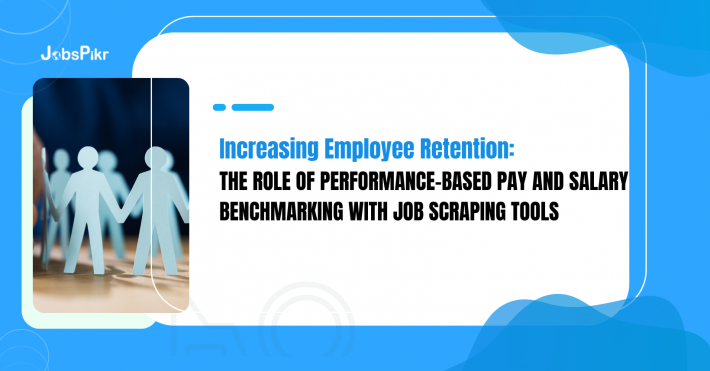Employee retention has emerged as a critical concern for organizations in 2023, with Forbes ranking it as the top issue to address. While factors like global movements and evolving employee expectations contribute to this challenge, it has been a persistent issue for businesses in recent years. High turnover rates incur additional costs related to recruitment, onboarding, and training, disrupting productivity and workflow. Moreover, team alignment can suffer, leading to a ripple effect throughout the organization.
To effectively address employee retention, companies must invest in job scraping tools and implement strategies that encourage employees to stay and empower them to thrive. Two key approaches are adopting a performance-based culture and ensuring competitive salaries through salary benchmarking.
By fostering a work environment that recognizes and rewards high performance, organizations can motivate employees to excel and feel valued. Additionally, aligning salaries with industry standards helps attract and retain top talent, demonstrating the organization’s commitment to fair compensation. Let’s look at each of these models in detail.
Performance-based Compensation Model
Performance-based compensation or merit pay isn’t a new concept by any means. It’s adopting a pay model closely aligned with employee output wherein people are rewarded for their performance and contributions to the organization.
One of the main reasons employees leave an organization is due to being underpaid and unvalued. Over their tenure, it brings down their morale and in due time such employees switch to a company that values them or rewards them better. Adopting performance-based compensation – via thorough research utilizing talent intelligence and job scraping tools – can tackle this issue by fostering a culture of fairness and merit where employees performing well are not overlooked but are fairly rewarded.

Source: Easy Metrics
The most significant impact of adopting this system, by far, would be felt in employee satisfaction and engagement levels. When employees can see a direct correlation between their paycheck and performance, they are more likely to go above and beyond their roles, feel appreciated, and imbue a higher level of job satisfaction. This reduces the likelihood of them hunting for new opportunities as they experience a sense of fulfillment in their current role.
To successfully implement a performance-based model, organizations must establish clear and transparent expectations from the beginning. These expectations should be objective, measurable, specific, and aligned with the SMART goals that are connected to the overall organizational objectives and roadmap. This clarity ensures that employees understand the criteria for salary advancement and the necessary steps to achieve it. Additionally, regular feedback, performance evaluations, and one-on-one sessions are essential for improvement and alignment with OKRs (Objectives and Key Results) also known as continuous performance management.

Source: Clear Review
Salary Benchmarking
A Performance-based salary model alone isn’t sufficient to improve employee retention rates if their compensation isn’t as per industry standards. Here, organizations must adopt a salary benchmarking exercise to ensure their packages are competitive with the market. Salary benchmarking also known as compensation benchmarking is a process of comparing an organization’s compensation structure with industry benchmarks for that role and market trends. It involves gathering data on salary ranges and utilizing competitor job data for similar roles and job levels, to ensure that the organization’s pay scales are aligned with the market.

Source: Husys
Salary benchmarking serves multiple purposes in increasing employee retention. Firstly, it provides organizations with valuable insights into the current market rates for specific roles. This enables them to make informed decisions when setting salary ranges, ensuring that their compensation remains competitive and attractive to employees. A comprehensive salary benchmarking analysis also helps organizations identify any significant gaps in their compensation structure, allowing them to address disparities and make necessary adjustments to retain top talent.
Another area where salary benchmarking plays a vital role is in fostering a sense of fairness and equity among employees. When the workforce understands their paycheck is based on accurate data sourced from market standards, they are more likely to feel valued and appreciated, as it showcases transparent communication. This also improves trust and loyalty toward the organization.
Businesses that adopt fair practices based on valuing and recognizing employees for the contributions they have or will provide, see a positive influence on satisfaction levels which then reduces the likelihood of employees seeking better compensation packages elsewhere. By regularly conducting salary benchmarking exercises, organizations can demonstrate their commitment to offering competitive and equitable compensation, ultimately improving employee retention rates.
Conclusion
Increasing employee retention rates involves a strategic approach that integrates performance-based pay, salary benchmarking, and the utilization of job scraping tools and talent intelligence. These tools play a crucial role in establishing and enhancing the framework for these two models. Job scraping tools enable organizations to gather up-to-date job market information, including competitor job openings and trends. This information helps recruiters identify talent needs and make informed hiring decisions. Additionally, talent intelligence helps organizations analyze the labor market, identify skill gaps, and determine appropriate compensation packages.
By combining a performance-based model with competitive salary practices, organizations can create a compelling work environment that values and rewards employee contributions, ultimately leading to higher retention rates and a more productive workforce.
JobsPikr helps businesses perform salary benchmarking by comparing their salary packages to those offered by similar companies in their region. This information can drive accurate decisions around employee compensation, such as adjusting wages from competitor job data to remain current or offering additional benefits to retain employees and improve morale.



